CHC50113 Early Childhood Education and Care: Knowledge Assessment
VerifiedAdded on 2023/06/18
|6
|1588
|80
Homework Assignment
AI Summary
This document presents a student's solution to a knowledge assessment for the CHC50113 Early Childhood Education and Care course. It covers various aspects of early childhood care, including methods for gathering information about children's health needs, procedures for recording and utilizing this information, immunization record updates, service safety monitoring, and strategies to support children's health responsibility. The solution also details service accident procedures, responses to possible illness cases, and workplace hazard identification and control. Furthermore, it addresses service procedures, staff responsibilities, and support for children with disabilities, highlighting the importance of inclusive practices and collaborative approaches in early childhood education. Desklib offers a platform to access this and many other solved assignments.
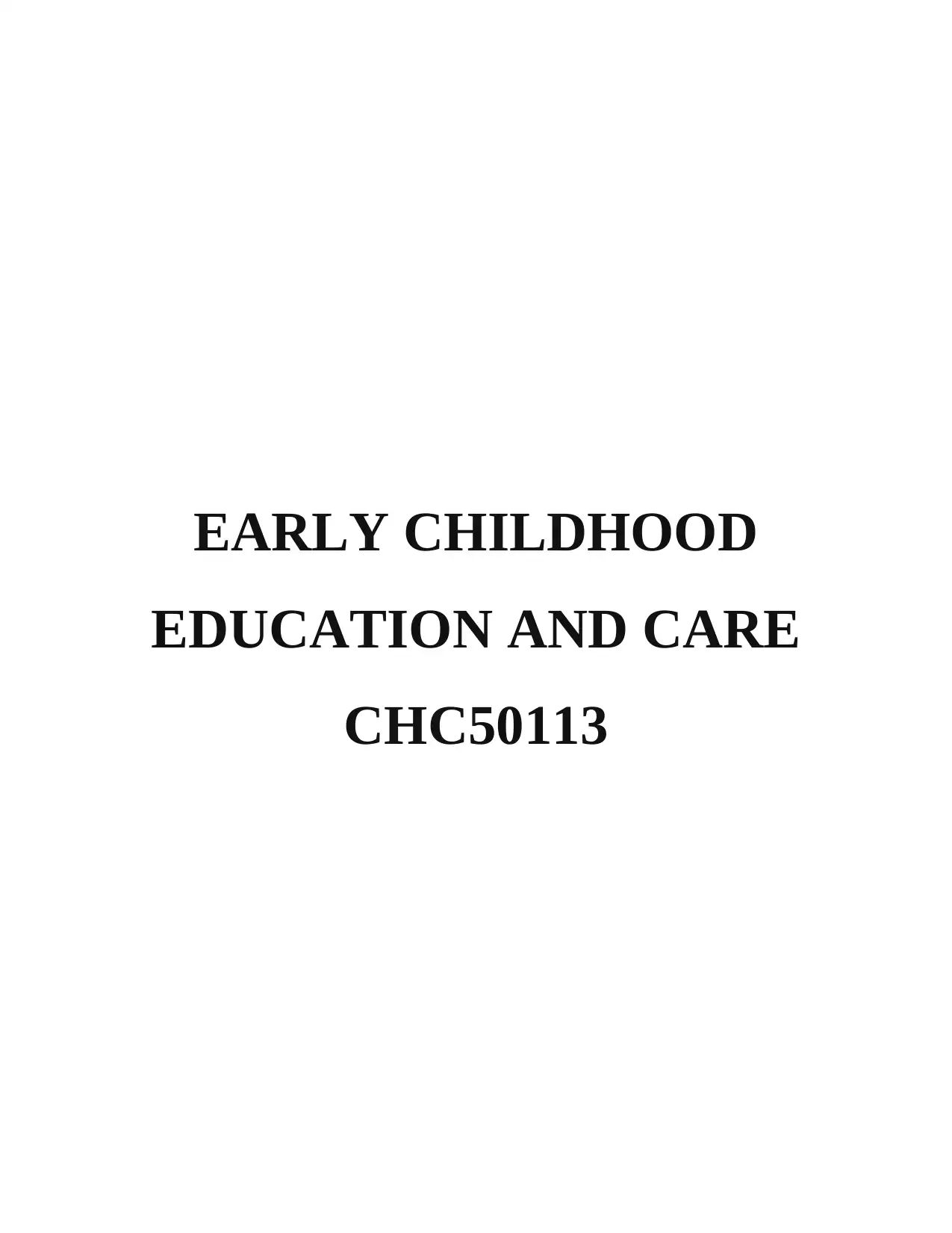
EARLY CHILDHOOD
EDUCATION AND CARE
CHC50113
EDUCATION AND CARE
CHC50113
Paraphrase This Document
Need a fresh take? Get an instant paraphrase of this document with our AI Paraphraser
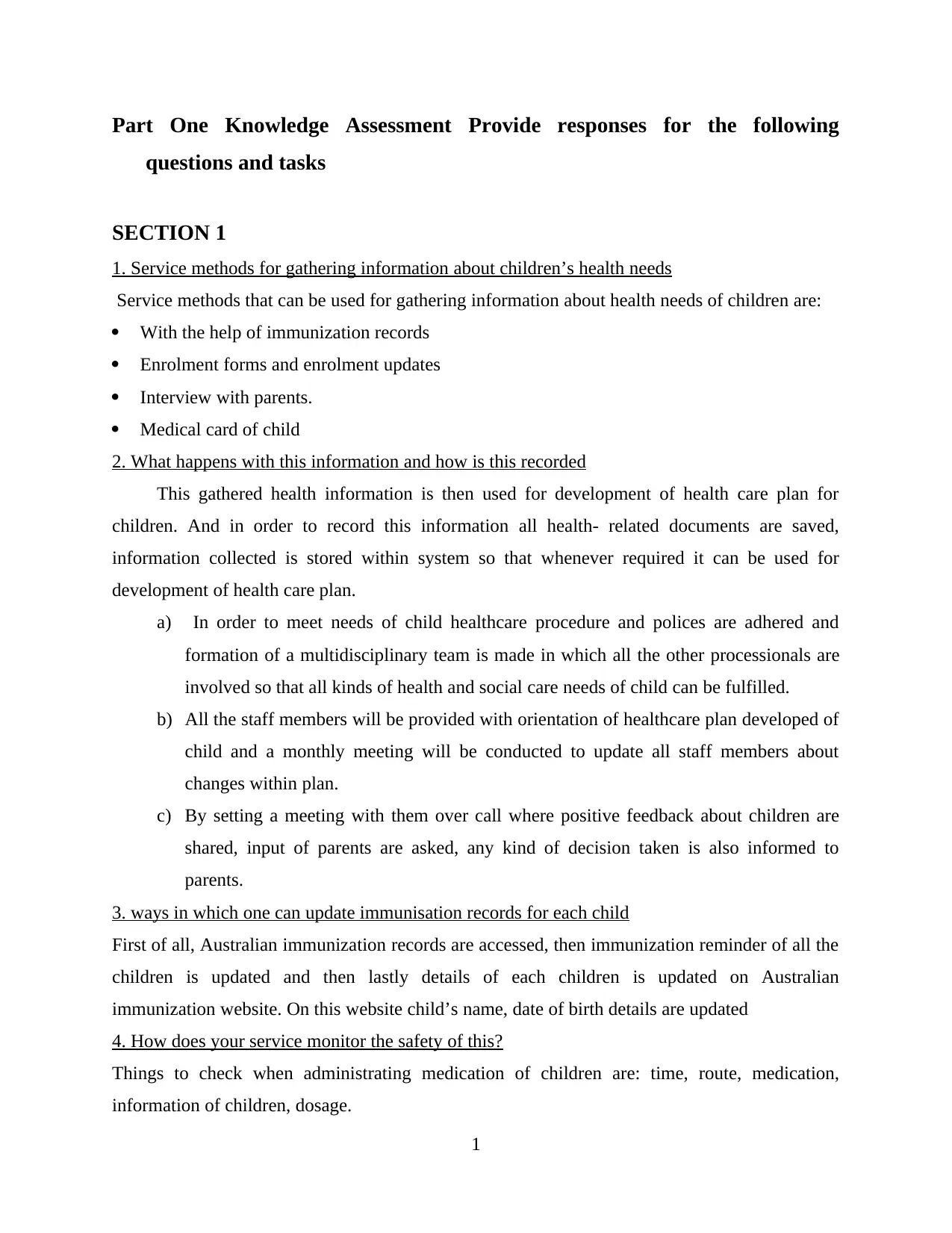
Part One Knowledge Assessment Provide responses for the following
questions and tasks
SECTION 1
1. Service methods for gathering information about children’s health needs
Service methods that can be used for gathering information about health needs of children are:
With the help of immunization records
Enrolment forms and enrolment updates
Interview with parents.
Medical card of child
2. What happens with this information and how is this recorded
This gathered health information is then used for development of health care plan for
children. And in order to record this information all health- related documents are saved,
information collected is stored within system so that whenever required it can be used for
development of health care plan.
a) In order to meet needs of child healthcare procedure and polices are adhered and
formation of a multidisciplinary team is made in which all the other processionals are
involved so that all kinds of health and social care needs of child can be fulfilled.
b) All the staff members will be provided with orientation of healthcare plan developed of
child and a monthly meeting will be conducted to update all staff members about
changes within plan.
c) By setting a meeting with them over call where positive feedback about children are
shared, input of parents are asked, any kind of decision taken is also informed to
parents.
3. ways in which one can update immunisation records for each child
First of all, Australian immunization records are accessed, then immunization reminder of all the
children is updated and then lastly details of each children is updated on Australian
immunization website. On this website child’s name, date of birth details are updated
4. How does your service monitor the safety of this?
Things to check when administrating medication of children are: time, route, medication,
information of children, dosage.
1
questions and tasks
SECTION 1
1. Service methods for gathering information about children’s health needs
Service methods that can be used for gathering information about health needs of children are:
With the help of immunization records
Enrolment forms and enrolment updates
Interview with parents.
Medical card of child
2. What happens with this information and how is this recorded
This gathered health information is then used for development of health care plan for
children. And in order to record this information all health- related documents are saved,
information collected is stored within system so that whenever required it can be used for
development of health care plan.
a) In order to meet needs of child healthcare procedure and polices are adhered and
formation of a multidisciplinary team is made in which all the other processionals are
involved so that all kinds of health and social care needs of child can be fulfilled.
b) All the staff members will be provided with orientation of healthcare plan developed of
child and a monthly meeting will be conducted to update all staff members about
changes within plan.
c) By setting a meeting with them over call where positive feedback about children are
shared, input of parents are asked, any kind of decision taken is also informed to
parents.
3. ways in which one can update immunisation records for each child
First of all, Australian immunization records are accessed, then immunization reminder of all the
children is updated and then lastly details of each children is updated on Australian
immunization website. On this website child’s name, date of birth details are updated
4. How does your service monitor the safety of this?
Things to check when administrating medication of children are: time, route, medication,
information of children, dosage.
1
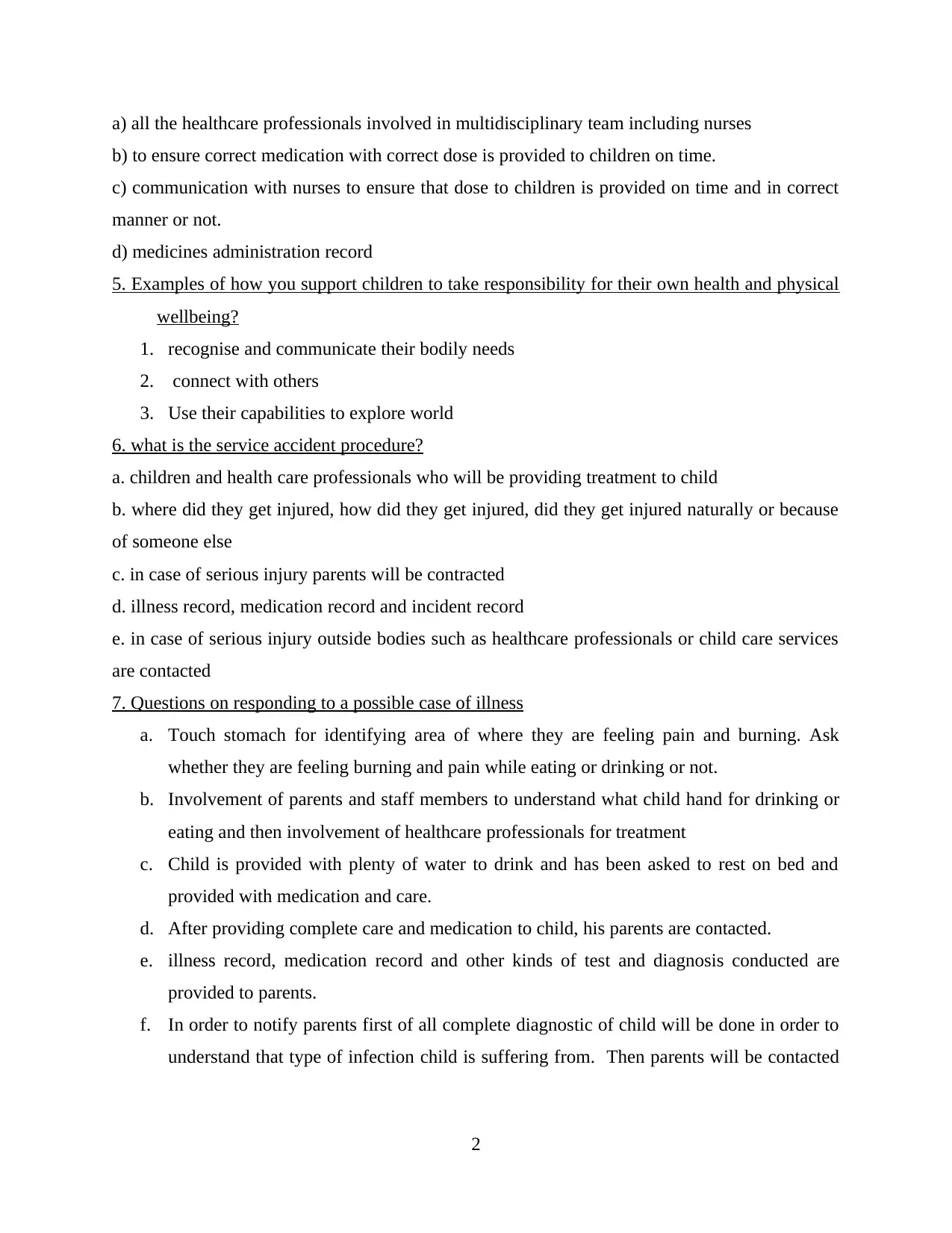
a) all the healthcare professionals involved in multidisciplinary team including nurses
b) to ensure correct medication with correct dose is provided to children on time.
c) communication with nurses to ensure that dose to children is provided on time and in correct
manner or not.
d) medicines administration record
5. Examples of how you support children to take responsibility for their own health and physical
wellbeing?
1. recognise and communicate their bodily needs
2. connect with others
3. Use their capabilities to explore world
6. what is the service accident procedure?
a. children and health care professionals who will be providing treatment to child
b. where did they get injured, how did they get injured, did they get injured naturally or because
of someone else
c. in case of serious injury parents will be contracted
d. illness record, medication record and incident record
e. in case of serious injury outside bodies such as healthcare professionals or child care services
are contacted
7. Questions on responding to a possible case of illness
a. Touch stomach for identifying area of where they are feeling pain and burning. Ask
whether they are feeling burning and pain while eating or drinking or not.
b. Involvement of parents and staff members to understand what child hand for drinking or
eating and then involvement of healthcare professionals for treatment
c. Child is provided with plenty of water to drink and has been asked to rest on bed and
provided with medication and care.
d. After providing complete care and medication to child, his parents are contacted.
e. illness record, medication record and other kinds of test and diagnosis conducted are
provided to parents.
f. In order to notify parents first of all complete diagnostic of child will be done in order to
understand that type of infection child is suffering from. Then parents will be contacted
2
b) to ensure correct medication with correct dose is provided to children on time.
c) communication with nurses to ensure that dose to children is provided on time and in correct
manner or not.
d) medicines administration record
5. Examples of how you support children to take responsibility for their own health and physical
wellbeing?
1. recognise and communicate their bodily needs
2. connect with others
3. Use their capabilities to explore world
6. what is the service accident procedure?
a. children and health care professionals who will be providing treatment to child
b. where did they get injured, how did they get injured, did they get injured naturally or because
of someone else
c. in case of serious injury parents will be contracted
d. illness record, medication record and incident record
e. in case of serious injury outside bodies such as healthcare professionals or child care services
are contacted
7. Questions on responding to a possible case of illness
a. Touch stomach for identifying area of where they are feeling pain and burning. Ask
whether they are feeling burning and pain while eating or drinking or not.
b. Involvement of parents and staff members to understand what child hand for drinking or
eating and then involvement of healthcare professionals for treatment
c. Child is provided with plenty of water to drink and has been asked to rest on bed and
provided with medication and care.
d. After providing complete care and medication to child, his parents are contacted.
e. illness record, medication record and other kinds of test and diagnosis conducted are
provided to parents.
f. In order to notify parents first of all complete diagnostic of child will be done in order to
understand that type of infection child is suffering from. Then parents will be contacted
2
⊘ This is a preview!⊘
Do you want full access?
Subscribe today to unlock all pages.

Trusted by 1+ million students worldwide
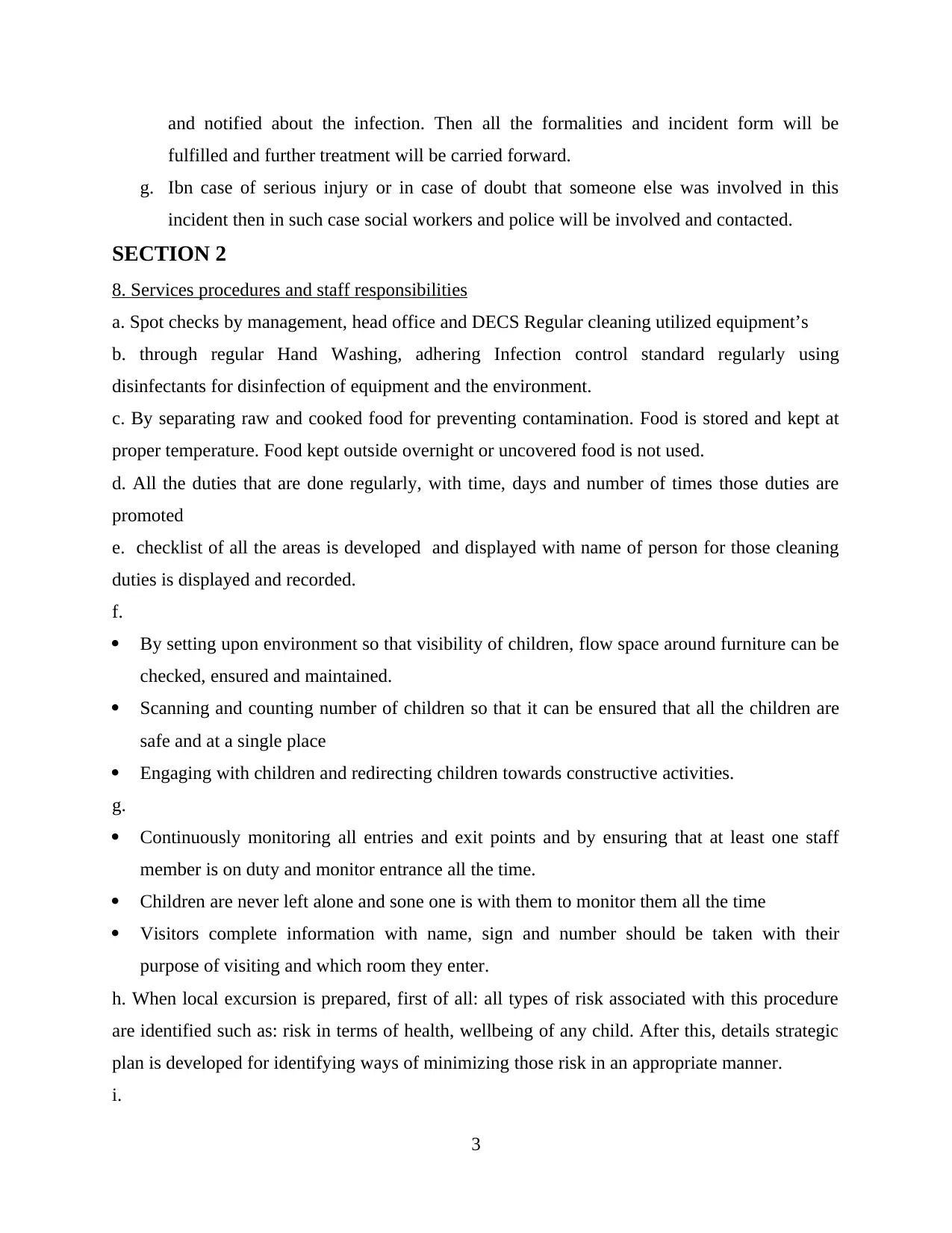
and notified about the infection. Then all the formalities and incident form will be
fulfilled and further treatment will be carried forward.
g. Ibn case of serious injury or in case of doubt that someone else was involved in this
incident then in such case social workers and police will be involved and contacted.
SECTION 2
8. Services procedures and staff responsibilities
a. Spot checks by management, head office and DECS Regular cleaning utilized equipment’s
b. through regular Hand Washing, adhering Infection control standard regularly using
disinfectants for disinfection of equipment and the environment.
c. By separating raw and cooked food for preventing contamination. Food is stored and kept at
proper temperature. Food kept outside overnight or uncovered food is not used.
d. All the duties that are done regularly, with time, days and number of times those duties are
promoted
e. checklist of all the areas is developed and displayed with name of person for those cleaning
duties is displayed and recorded.
f.
By setting upon environment so that visibility of children, flow space around furniture can be
checked, ensured and maintained.
Scanning and counting number of children so that it can be ensured that all the children are
safe and at a single place
Engaging with children and redirecting children towards constructive activities.
g.
Continuously monitoring all entries and exit points and by ensuring that at least one staff
member is on duty and monitor entrance all the time.
Children are never left alone and sone one is with them to monitor them all the time
Visitors complete information with name, sign and number should be taken with their
purpose of visiting and which room they enter.
h. When local excursion is prepared, first of all: all types of risk associated with this procedure
are identified such as: risk in terms of health, wellbeing of any child. After this, details strategic
plan is developed for identifying ways of minimizing those risk in an appropriate manner.
i.
3
fulfilled and further treatment will be carried forward.
g. Ibn case of serious injury or in case of doubt that someone else was involved in this
incident then in such case social workers and police will be involved and contacted.
SECTION 2
8. Services procedures and staff responsibilities
a. Spot checks by management, head office and DECS Regular cleaning utilized equipment’s
b. through regular Hand Washing, adhering Infection control standard regularly using
disinfectants for disinfection of equipment and the environment.
c. By separating raw and cooked food for preventing contamination. Food is stored and kept at
proper temperature. Food kept outside overnight or uncovered food is not used.
d. All the duties that are done regularly, with time, days and number of times those duties are
promoted
e. checklist of all the areas is developed and displayed with name of person for those cleaning
duties is displayed and recorded.
f.
By setting upon environment so that visibility of children, flow space around furniture can be
checked, ensured and maintained.
Scanning and counting number of children so that it can be ensured that all the children are
safe and at a single place
Engaging with children and redirecting children towards constructive activities.
g.
Continuously monitoring all entries and exit points and by ensuring that at least one staff
member is on duty and monitor entrance all the time.
Children are never left alone and sone one is with them to monitor them all the time
Visitors complete information with name, sign and number should be taken with their
purpose of visiting and which room they enter.
h. When local excursion is prepared, first of all: all types of risk associated with this procedure
are identified such as: risk in terms of health, wellbeing of any child. After this, details strategic
plan is developed for identifying ways of minimizing those risk in an appropriate manner.
i.
3
Paraphrase This Document
Need a fresh take? Get an instant paraphrase of this document with our AI Paraphraser
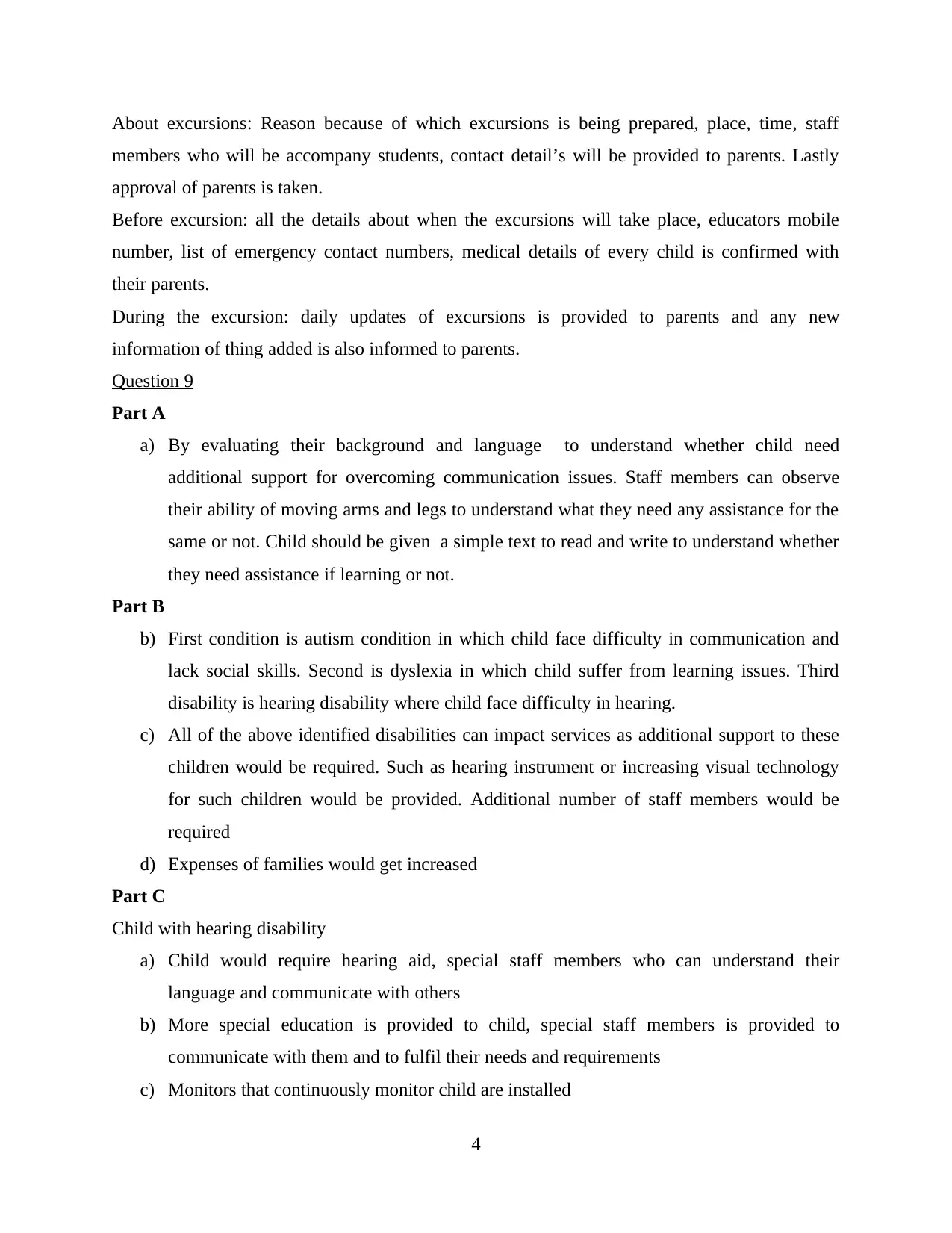
About excursions: Reason because of which excursions is being prepared, place, time, staff
members who will be accompany students, contact detail’s will be provided to parents. Lastly
approval of parents is taken.
Before excursion: all the details about when the excursions will take place, educators mobile
number, list of emergency contact numbers, medical details of every child is confirmed with
their parents.
During the excursion: daily updates of excursions is provided to parents and any new
information of thing added is also informed to parents.
Question 9
Part A
a) By evaluating their background and language to understand whether child need
additional support for overcoming communication issues. Staff members can observe
their ability of moving arms and legs to understand what they need any assistance for the
same or not. Child should be given a simple text to read and write to understand whether
they need assistance if learning or not.
Part B
b) First condition is autism condition in which child face difficulty in communication and
lack social skills. Second is dyslexia in which child suffer from learning issues. Third
disability is hearing disability where child face difficulty in hearing.
c) All of the above identified disabilities can impact services as additional support to these
children would be required. Such as hearing instrument or increasing visual technology
for such children would be provided. Additional number of staff members would be
required
d) Expenses of families would get increased
Part C
Child with hearing disability
a) Child would require hearing aid, special staff members who can understand their
language and communicate with others
b) More special education is provided to child, special staff members is provided to
communicate with them and to fulfil their needs and requirements
c) Monitors that continuously monitor child are installed
4
members who will be accompany students, contact detail’s will be provided to parents. Lastly
approval of parents is taken.
Before excursion: all the details about when the excursions will take place, educators mobile
number, list of emergency contact numbers, medical details of every child is confirmed with
their parents.
During the excursion: daily updates of excursions is provided to parents and any new
information of thing added is also informed to parents.
Question 9
Part A
a) By evaluating their background and language to understand whether child need
additional support for overcoming communication issues. Staff members can observe
their ability of moving arms and legs to understand what they need any assistance for the
same or not. Child should be given a simple text to read and write to understand whether
they need assistance if learning or not.
Part B
b) First condition is autism condition in which child face difficulty in communication and
lack social skills. Second is dyslexia in which child suffer from learning issues. Third
disability is hearing disability where child face difficulty in hearing.
c) All of the above identified disabilities can impact services as additional support to these
children would be required. Such as hearing instrument or increasing visual technology
for such children would be provided. Additional number of staff members would be
required
d) Expenses of families would get increased
Part C
Child with hearing disability
a) Child would require hearing aid, special staff members who can understand their
language and communicate with others
b) More special education is provided to child, special staff members is provided to
communicate with them and to fulfil their needs and requirements
c) Monitors that continuously monitor child are installed
4
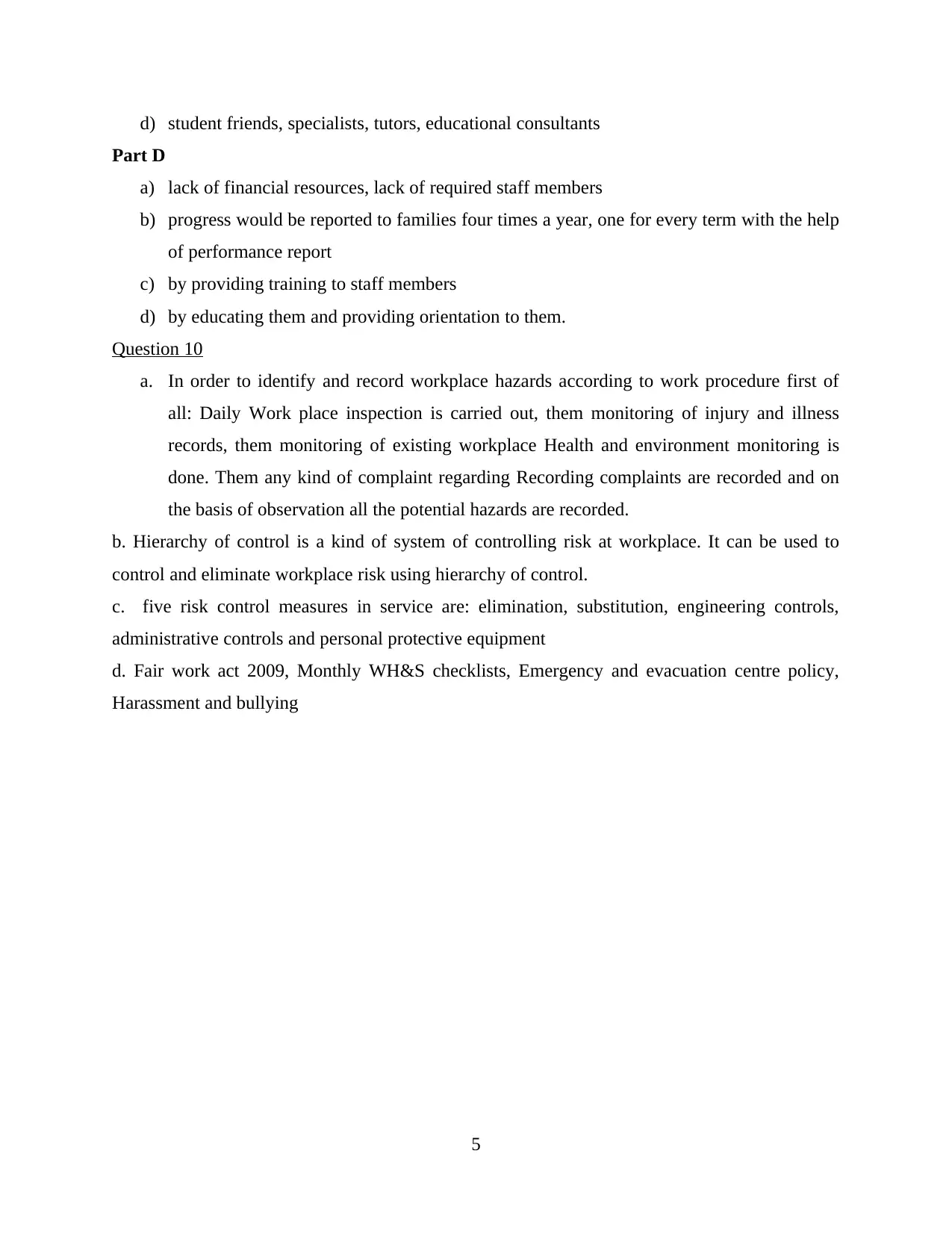
d) student friends, specialists, tutors, educational consultants
Part D
a) lack of financial resources, lack of required staff members
b) progress would be reported to families four times a year, one for every term with the help
of performance report
c) by providing training to staff members
d) by educating them and providing orientation to them.
Question 10
a. In order to identify and record workplace hazards according to work procedure first of
all: Daily Work place inspection is carried out, them monitoring of injury and illness
records, them monitoring of existing workplace Health and environment monitoring is
done. Them any kind of complaint regarding Recording complaints are recorded and on
the basis of observation all the potential hazards are recorded.
b. Hierarchy of control is a kind of system of controlling risk at workplace. It can be used to
control and eliminate workplace risk using hierarchy of control.
c. five risk control measures in service are: elimination, substitution, engineering controls,
administrative controls and personal protective equipment
d. Fair work act 2009, Monthly WH&S checklists, Emergency and evacuation centre policy,
Harassment and bullying
5
Part D
a) lack of financial resources, lack of required staff members
b) progress would be reported to families four times a year, one for every term with the help
of performance report
c) by providing training to staff members
d) by educating them and providing orientation to them.
Question 10
a. In order to identify and record workplace hazards according to work procedure first of
all: Daily Work place inspection is carried out, them monitoring of injury and illness
records, them monitoring of existing workplace Health and environment monitoring is
done. Them any kind of complaint regarding Recording complaints are recorded and on
the basis of observation all the potential hazards are recorded.
b. Hierarchy of control is a kind of system of controlling risk at workplace. It can be used to
control and eliminate workplace risk using hierarchy of control.
c. five risk control measures in service are: elimination, substitution, engineering controls,
administrative controls and personal protective equipment
d. Fair work act 2009, Monthly WH&S checklists, Emergency and evacuation centre policy,
Harassment and bullying
5
⊘ This is a preview!⊘
Do you want full access?
Subscribe today to unlock all pages.

Trusted by 1+ million students worldwide
1 out of 6
Related Documents
Your All-in-One AI-Powered Toolkit for Academic Success.
+13062052269
info@desklib.com
Available 24*7 on WhatsApp / Email
![[object Object]](/_next/static/media/star-bottom.7253800d.svg)
Unlock your academic potential
Copyright © 2020–2025 A2Z Services. All Rights Reserved. Developed and managed by ZUCOL.





